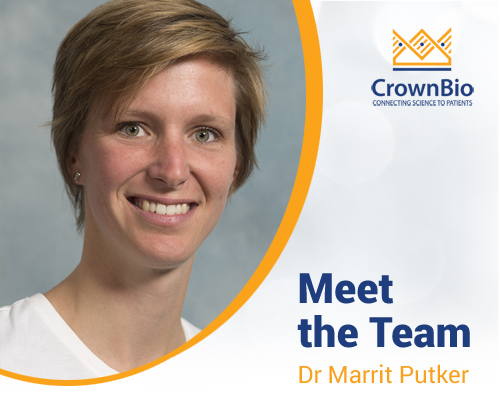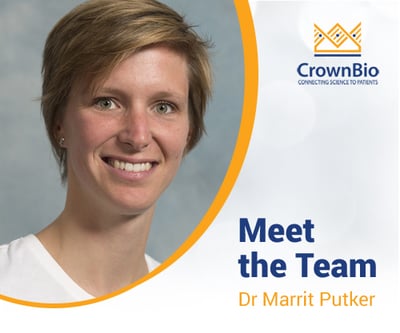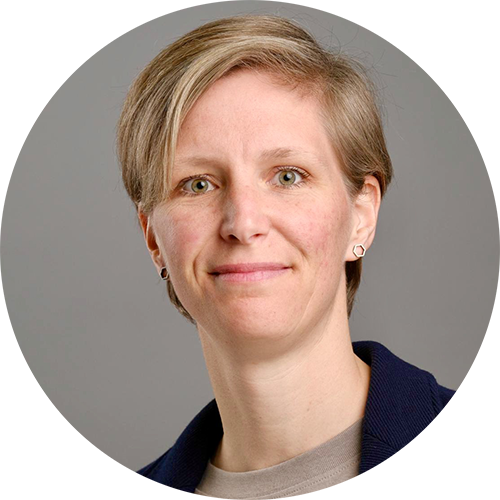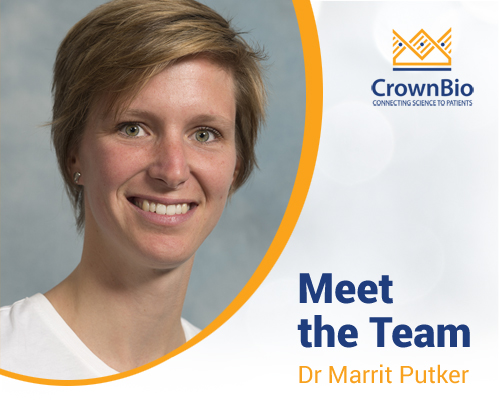Meet the CrownBio Team: Dr Marrit Putker, Organoid Research Scientist

 Meet the newest member of CrownBio’s organoid team, Marrit Putker, heading up research at our new Utrecht site.
Meet the newest member of CrownBio’s organoid team, Marrit Putker, heading up research at our new Utrecht site.
Welcome to CrownBio, would you like to introduce yourself and your background?
Thank you. My name is Marrit Putker and I am proud to be the first scientist at the new CrownBio facility in Utrecht in the Netherlands. I am a molecular cancer biologist by training with over 14 years of lab experience. Before starting at CrownBio, I was working as a Postdoctoral fellow in the lab of Hans Clevers, organoid pioneer and HUB founder. I worked with many kinds of organoid models in my research, including studying the day-night rhythm of tumor cells.
What will your new role and responsibilities at CrownBio entail?
As lead scientist it’s my task to set up a well-functioning lab and to recruit and train staff to grow the team. I’ll also be overseeing research projects and model development, both here in the Netherlands as well as in collaboration with our labs in America and China. At the Utrecht site, we’ll be combining R&D activities, such as developing novel organoid-based immuno-oncology assays, with client projects and I’ll be running these initiatives.
With my many years’ experience in the organoid field, I’ll also be helping to raise awareness in the industry on the advantages of using organoids as preclinical research models. I’m happy to share my knowledge on the opportunities and challenges of these models with both colleagues and clients.
You're one of the first staff at our new Netherlands site, how are you finding the challenge of setting up a new site?
It’s both an incredible opportunity and a challenge to setup a new lab from scratch! Being local to Utrecht is a great advantage as I know my way around and know who to speak to; luckily everyone is very happy to help. Also, being backed up by the global environment of CrownBio gives me great support, and it’s great to see everyone being so excited about our new site being realized.
You'll be bringing a lot of expertise around HUB Organoids™. Can you explain a bit more about these models and their key features?
HUB Organoids are like mini-organs in a dish. They grow out from the adult stem cells present in (epithelial) tissues, and retain the characteristics of the specific tissue that the cells were taken from. Like in the body, the stem cells are able to proliferate but also to differentiate into functional cells. Similarly, when growing organoids from a cancerous tissue, tumor organoids grow out that reflect the characteristics of that particular tumor.
Since we are able to grow these mini-organs almost indefinitely in a very reproducible manner this gives us the opportunity to generate biobanks of hundreds or even thousands of tumors (and their healthy counterparts). These reflect the vast variety of tumors and clinical patients, allowing us to study their (drug response) behaviour in vitro, making tumor organoids an invaluable tool for preclinical cancer research.
Can you explain what sets HUB Organoids apart from other organoid technologies?
Organoids can be grown from adult stem cells (ASCs), resulting in the patented HUB organoids, or from induced pluripotent stem cells (iPSCs) that in turn are differentiated into the organ of interest. The latter technology is slightly more flexible regarding tissue availability. As cells are reprogrammed all the way back to pluripotency, it’s possible to also grow organoids from tissues for which no HUB protocols are available (for example, non-epithelial tissues such as the brain or blood cells). However, it also often results in less mature and less reproducible models compared to HUB Organoids, and, on average, it takes more time to establish this type of organoid.
When it comes to tumor organoids, HUB Organoids have so far been unmatched. Generating iPSCs from a (mutated) tumor cell to then differentiate them into tumor organoids is very complex, if not virtually impossible. Moreover, it brings a lot of uncertainties regarding their representativeness of tumor biology and therefore their predictive strength.
In contrast, HUB Organoid Technology allows the growth of organoids directly from tumor (stem) cells, which therefore exactly represent the specific tumor we are interested in. Indeed, HUB Organoids are proven to closely recapitulate in vivo tumor morphology and drug responses.
Are there other any organoid technologies available for oncology research and drug development?
As I discussed above, growing iPSCs from tumor cells is not only a detour, but also comes with uncertainties. Alternatively, one could generate ‘minimal’ tumors from healthy organoids, by introducing driver mutations using eg CRISPR-Cas9 methods. These artificial tumors can be generated from both ASC and iPSC-derived organoids and can be interesting when you’re interested in particular mutations in a healthy background.
Other than that, no other in vitro organoid technology is available that represents tumor biology, drug responses, and patient populations so closely as HUB Organoids.
What do you think is the future/will be the next big developments in organoid research?
Growing organoids is getting more and more efficient, and assays currently in development will allow smaller numbers of organoids to be required per experiment. Combining this with novel high-throughput assays, possibly imaging-based, and innovative bioinformatic analysis, will allow for bigger screens with more output and faster turnaround times.
Identifying and specifying indications for specific drugs (“clinical trials in a dish”) can be combined in high-throughput matrix screens with lead compound identification, compound efficiency testing or even combinatory drug screens. We will be able to streamline the drug development timeline and fine-tune which patient cohorts will respond to particular treatments and which not, improving the starting point for clinical trials.
Next to this, we will be able to assay more complex interactions between cancer cells and their environment. Co-cultures of organoids with immune cells, but also with mesenchyme or microbiome components, in combination with these novel drug screening methods, will allow for answering a plethora of questions that haven’t even been asked yet!



